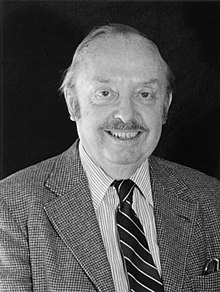Keith R. Porter
Keith Roberts Porter | |
|---|---|
 | |
| Born | June 11, 1912 Yarmouth, Nova Scotia, Canada |
| Died | May 2, 1997 (aged 84) Bryn Mawr, Pennsylvania, U.S. |
| Nationality | Canadian, American |
| Occupation | Cell biologist |
Keith Roberts Porter (June 11, 1912 – May 2, 1997) was a
Early life and education
Keith Porter was born in
Career/research
In 1939, Porter was a research assistant at The Rockefeller Institute for Medical Research under James B. Murphy, a cancer researcher. Porter focused his early work in Murphy's lab on the effect of carcinogens on
From 1961 to 1967, Porter returned to Harvard University and was chair of the biology department (1965–1967). Porter's research at Harvard concerned the sarcoplasmic reticulum and T system; he conducted this work in collaboration with Clara Franzini-Amstrong. He then explored the role of microtubules in motility, cell division, and control of cell shape with Lewis Tilney, J. Richard McIntosh, and Ursula Goodenough-Johnson.[4]
In 1968, Porter left to work as chair of the new Department of Molecular, Cellular, and Developmental Biology at the University of Colorado Boulder. Porter spearheaded a laboratory dedicated to a higher voltage (1000 kV) electron microscope that improved the ability to examine the interior of cells by virtue of its high penetrating power.[5] When he retired, at age 70, the university awarded him an honorary degree and renamed "his" building Porter Biosciences.
Porter became a professor at the University of Maryland, Baltimore County (UMBC) in 1984 before joining Lee D. Peachey’s laboratory at the University of Pennsylvania in 1988, post-retirement. UMBC's Keith R. Porter Core Imaging Facility is dedicated to Porter.
Porter helped found the American Society for Cell Biology and the Journal of Cell Biology. The Keith R. Porter Endowment for Cell Biology, founded in 1981, supports an annual Keith R. Porter Lecture at the conference of American Society for Cell Biology.
Recognition
In 1970, together with
Awards and honors
- 1957 elected to the American Academy of Arts and Sciences[7]
- 1964 Gairdner Foundation International Award
- 1964 elected to the United States National Academy of Sciences[8]
- 1970 Louisa Gross Horwitz Prize of Columbia University
- 1971 Dickson Prize in Science
- 1971 Paul Ehrlich and Ludwig Darmstaedter Prize
- 1976 National Medal of Science
- 1977 elected to the American Philosophical Society[9]
- 1981 E. B. Wilson Medal
References
- ^ Schliwa, M. (1997). Keith roberts porter (1912-97). Nature, 387(6635), 764.
- ^ Peachey, L. D. (2006). Keith roberts porter. Proceedings of the American Philosophical Society, 150(4), 685.
- ^ a b c Satir, P. (1997). Keith R. porter and the first electron micrograph of a cell. Endeavour, 21(4), 169-171.
- ^ Peachey, L. D. (2013). Keith R. porter. National Academy of Sciences, 1-21.
- ^ Palade, G. E. (1977). Keith Roberts Porter and the development of contemporary cell biology. The Journal of Cell Biology, 75(1), D1.
- ^ Westly, Erica (October 6, 2008). "No Nobel for You: Top 10 Nobel Snubs". Scientific American.
- ^ "Keith Roberts Porter". American Academy of Arts & Sciences. Retrieved 2022-07-19.
- ^ "Keith R. Porter". www.nasonline.org. Retrieved 2022-07-19.
- ^ "APS Member History". search.amphilsoc.org. Retrieved 2022-07-19.
- Moberg CL (March 1995). "The electron microscope enters the realm of the intact cell". J. Exp. Med. 181 (3): 831–7. PMID 7869045.
- Moberg CL (1996). "Keith Porter and the Founding of the Tissue Culture Association". In Vitro Cell Dev Biol Anim. 32 (10): 663–9. S2CID 12844113.
- Satir P (July 1997). "Keith Roberts Porter: 1912–1997". J. Cell Biol. 138 (2): 223–4. PMID 9273349.
- Keith Porter biography and images, Image & Video Library of The American Society for Cell Biology
External links
- The Official Site of Louisa Gross Horwitz Prize
- Keith R. Porter Papers (1938–1993) at the University of Colorado at Boulder
- Keith Porter papers, 1950-1987 at the University of Maryland, Baltimore County
